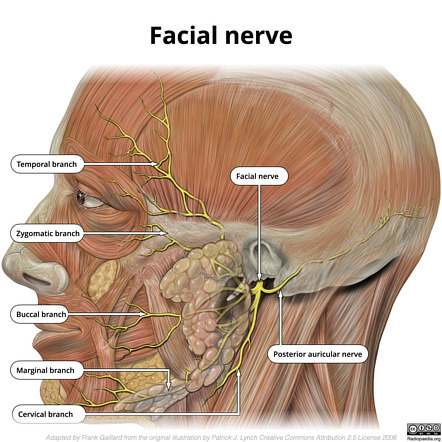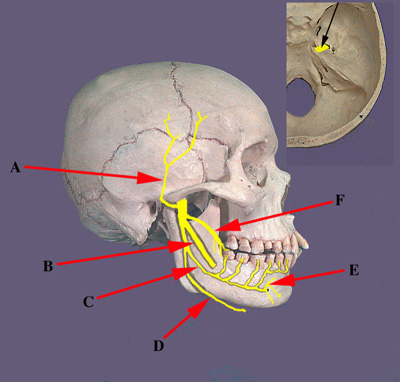Branches of mandibular nerve to otic ganglion - e-Anatomy - IMAIOS
Por um escritor misterioso
Last updated 20 maio 2024

The neuronal branches of mandibular nerve to otic ganglion come via its sensory, parasympathetic, sympathetic and motor roots.Please note that the otic ganglion is a parasympathetic ganglion formed by cell bodies of postganglionic parasympathetic fibers. It is situated close to the main trunk of the mandibular nerve (V3), inside the infratemporal fossa and just inferior to the foramen ovale.Sensory root: The auriculotemporal nerve–which is a branch of the posterior division of mandibular nerve (V3)–gives off a sensory root to the otic ganglion. Some general somatic sensory neurons from the capsule and fascia of parotid gland, pass ‘unrelayed’ through the otic ganglion and its sensory root to reach the auriculotemporal nerve. These sensory neurons transmit sensations of pain, touch, temperature and pressure and end up as far as the sensory trigeminal ganglion via this route.Parasympathetic root: The parasympathetic root to otic ganglion is secretomotor and comes off from the lesser petrosal nerve. The preganglionic parasympathetic neurons follow the following route to reach the otic ganglion:Origin from the inferior salivatory nucleus of facial nerve > via tympanic branch of glossopharyngeal nerve > tympanic plexus (middle ear) > lesser petrosal nerve (passes via foramen ovale) > otic ganglion (in infratemporal fossa).Next, the post-ganglionic neurons from the otic ganglion hop onto the auriculotemporal nerve–a branch of V3–to end up providing secretomotor innervation to the parotid gland mainly.Sympathetic root: The sympathetic root arises from the sympathetic plexus around the middle meningeal artery. It contains post-ganglionic sympathetic neurons which arise from the superior cervical ganglion. They pass through otic ganglion without relay and hop onto the auriculotemporal nerve. Here, they run along with the postganglionic sympathetic neurons to eventually end up reaching the parotid gland. Sympathetics lead to vasoconstriction of parotid vessels, thus decreasing secretions.Motor root: The nerve to medial pterygoid muscle–which is a branch of the main trunk of V3–gives off a motor root to the otic ganglion. Some somatic motor neurons from the V3 reach the otic ganglion via the motor root. These efferent neurons pass ‘unrelayed’ through the ganglion and end up innervating two muscles, including the tensor tympani and the tensor veli palatini muscles.

Dr Rajesh K Kaushal - Anatomy Revision Programme - Q. INCORRECT

Mandibular nerve , Anatomy QA

Posterior division of mandibular nerve - e-Anatomy - IMAIOS

Sensory root of submandibular ganglion; Ganglionic branches to

Otic Ganglion – Earth's Lab

1-Lateral & medial pterygoids (muscles of mastication). 2-Branches

Posterior division of mandibular nerve - e-Anatomy - IMAIOS

Otic Ganglion , Location, Roots or Connections and Branches
What function does the trochlear nerve have? - Quora

Mandibular nerve and otic ganglion
Recomendado para você
-
 Mandibular nerve - Wikipedia20 maio 2024
Mandibular nerve - Wikipedia20 maio 2024 -
 Marginal mandibular nerve, Radiology Reference Article20 maio 2024
Marginal mandibular nerve, Radiology Reference Article20 maio 2024 -
 Branches of Mandibular Nerve - From the Trunk & Anterior division20 maio 2024
Branches of Mandibular Nerve - From the Trunk & Anterior division20 maio 2024 -
 Cranial Nerve V - Trigeminal V3 - Mandibular Division Diagram20 maio 2024
Cranial Nerve V - Trigeminal V3 - Mandibular Division Diagram20 maio 2024 -
 Mandibular Nerve Branches20 maio 2024
Mandibular Nerve Branches20 maio 2024 -
 Anatomy of the trigeminal nerve (CN V): Video20 maio 2024
Anatomy of the trigeminal nerve (CN V): Video20 maio 2024 -
 Diagrammatic representation of the normal anatomy of the mandibular20 maio 2024
Diagrammatic representation of the normal anatomy of the mandibular20 maio 2024 -
 Mandibular nerve branches Diagram20 maio 2024
Mandibular nerve branches Diagram20 maio 2024 -
 Mandibular Nerve, Formation, Course, Relations20 maio 2024
Mandibular Nerve, Formation, Course, Relations20 maio 2024 -
 Marginal Mandibular Nerve Weakness (Ramus Mandibularis) - Level I Neck Dissection (extended) recurrent pleomorphic adenoma - Clinical case example20 maio 2024
Marginal Mandibular Nerve Weakness (Ramus Mandibularis) - Level I Neck Dissection (extended) recurrent pleomorphic adenoma - Clinical case example20 maio 2024
você pode gostar
-
 900+ Sonic characters ideas sonic, sonic art, sonic the hedgehog20 maio 2024
900+ Sonic characters ideas sonic, sonic art, sonic the hedgehog20 maio 2024 -
 About me — Meet the revamped Recovery Au! Playtime co.20 maio 2024
About me — Meet the revamped Recovery Au! Playtime co.20 maio 2024 -
 Julia MineGirl | Greeting Card20 maio 2024
Julia MineGirl | Greeting Card20 maio 2024 -
 Auction Prices Realized Tcg Cards 2022 Pokemon Sword & Shield Silver Tempest Full Art/Unown V20 maio 2024
Auction Prices Realized Tcg Cards 2022 Pokemon Sword & Shield Silver Tempest Full Art/Unown V20 maio 2024 -
 Confirmado TV anime de Big Order, do mesmo autor de Mirai Nikki - Chuva de Nanquim20 maio 2024
Confirmado TV anime de Big Order, do mesmo autor de Mirai Nikki - Chuva de Nanquim20 maio 2024 -
 Fronteras20 maio 2024
Fronteras20 maio 2024 -
 One Piece The Power of Ice Oni! A New Version of the Plague20 maio 2024
One Piece The Power of Ice Oni! A New Version of the Plague20 maio 2024 -
 Shadow, Dublapédia20 maio 2024
Shadow, Dublapédia20 maio 2024 -
 ELLIOT MR. ROBOT por Zanation Jogos de desenho, Desenhar online, Desenhos20 maio 2024
ELLIOT MR. ROBOT por Zanation Jogos de desenho, Desenhar online, Desenhos20 maio 2024 -
Anime News And Facts on X: Pic 1: Chainsaw Man Episode 5 Pic 2: From the promo trailer / X20 maio 2024
